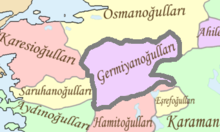Germiyan
The Germiyan or Germiyaniden ( Turkish Germiyanoğulları ) were an Anatolian Beylik with the capital Kütahya and one of the most famous frontier principalities ( Uc ) of the Oghuz tribes after the fall of the Rumseldschuks Sultanate . It existed from 1300 to 1429.
For a short time in the second half of the 14th century, the Germiyan were the most powerful power in Anatolia after the Karamanids . But they were later taken over by the neighboring dynasty of the Ottomans, who were to found the Ottoman Empire .
The Germiyan played an important role in the colonization of the Aegean coast by the Turks. The founders of the principalities of the Aydınoğulları , the Saruchanids , the İnançoğlu and the Mentesche were all former commanders of the Germiyan.
The Beylik was founded by the Afshar , an Oghus tribe. As a result of the Mongol invasion of Iran, the tribe left the regions around Fars and Kerman and migrated towards Western Anatolia, staying in the Malatya area for a while before moving to Kütahya, where they quickly established the Beylik.
The Germiyan rebelled against their Seljuk overlords in 1283 when Sultan Kai Chosrau III. was executed and Mas'ud II came to the throne thanks to the Mongols. The battle between the Mongol-Seljuk armies from Konya and the rebels from Germiyan continued until 1290. An agreement was only reached in 1299, with which the Germiyan also came into possession of Ankara . When the governor of the Ilkhan Amir Tschupan took over Anatolia in 1314, the Germiyan declared their loyalty and concentrated their raids on areas to the west of themselves.
Their western neighbors, the Beyliks of Mentesche, Aydınoğulları, İnançoğlu, Saruchaniden and Karesi , were in their early days subjects of the Germiyan, while the southern Beyliks of the Sâhib Ata and the Hamidoğlu relied on the Germiyan's protection against the Karamanids. North of the Germiyan, Byzantine sources tell of an Umur Bey, a commander and son-in-law of the Germiyan, who is said to have owned Paphlagonia . Later the beylik of the Candaro ğlu was formed here .
The Germiyan were eventually surrounded by new Beyliks established by their own former commanders. Thus they were denied access to the coast or the Byzantine territory. Their powerful neighbors, the Karamanids, exerted constant pressure from the east and the Germiyan came under the influence of the Ottomans over time, so that from 1429 they were absorbed into the Ottoman Empire .
The current province of Kütahya was initially a sanjak and later the Vilayet Germiyan until the early years of the Republic of Turkey when the province was renamed after the provincial capital Kütahya.
The founding dynasty of the Beyliks had many descendants who served the Ottomans and even the Republic of Turkey. A well-known descendant was the grand vizier of the 19th century. Abdurrahman Nureddin Pasha .
swell
- Mehmet Fuat Köprülü , Gary Leiser: The Origins of the Ottoman Empire . SUNY Press, 1992, ISBN 0-7914-0819-1 ( limited preview in Google Book Search).
